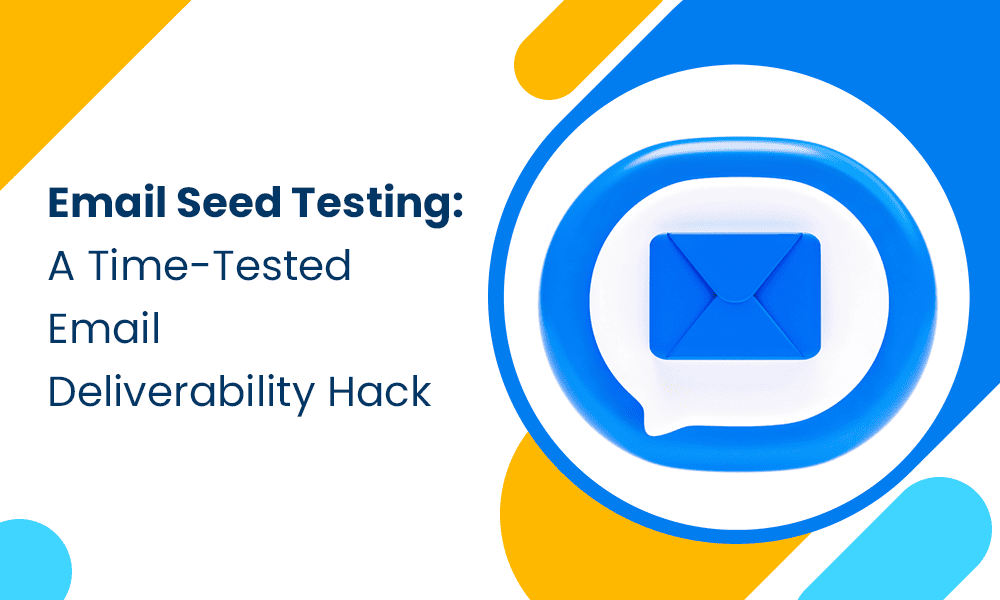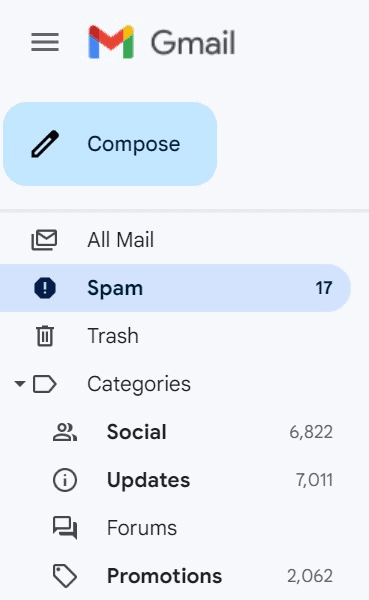Who can tell if the emails you’re about to send will land in your subscribers’ inboxes? Email service providers keep their cards close to their chest regarding spam filter rules.
You might pass a spam check with one and fail another. It’s a tough call, but you don’t want to be caught on the wrong foot – especially if you have been flagged for spam in the past.
An effective, low-cost solution to this problem is seed testing for email deliverability. It takes some effort, but it can help you identify and fix the real problem that may have eluded you all this while.
In this article, we’ll go over the basics of email seed testing and how you can use it to turn around your email marketing fortunes. We’ll cover:
- What is email seed testing?
- How to run an email seed testing campaign?
- Best practices for email seed testing
Table of Contents
What Is Email Seed Testing?
In a nutshell, seed testing is inbox placement testing. It tests your emails to ensure they inbox and don’t land in spam – all before you send them to real subscribers. Think of it as a trial run before showtime! You’ll know exactly what to do and where based on the results.
In other words, the cause of the deliverability problem and the provider it’s with. You can then go to work on optimizing your emails for better performance.
With email seed testing, you can sort out many technical issues, like email bounces, spam checks, and authentication mismatches.
You can also handle user experience issues, like broken links, shaky text, image alignment, bad readability, and responsiveness. By addressing these issues in advance, you know that you’ve done the right thing – at least as far as spam filters go!
👉 Elevate your email marketing with our free email templates designed to boost engagement and conversions.
Why You Need Seed Testing in Email Marketing
Gmail blocked 49% of all emails for spam in 2022. Yet, they won’t give senders exact numbers regarding email placement. At best, they’ll tell you if your emails bounced. There’s no way to know how many made it to the inbox, how many got sent to spam, or the promotions tab.
It’s up to you to do the homework and find ways to avoid technical and aesthetic issues that might show up. Moreover, Apple’s Mail Privacy Protection (MPP) has skewed open rates so much that you can no longer peg your email deliverability rate against it.
A couple of years ago, a 25% open rate meant a good percentage of your email likely landed on target. Today, MMP pre-downloads images without the user necessarily clicking on an email. Marketers can’t tell if it was a genuine user engagement.
There’s no way MPP can beat good old email seed testing!
Read also: How To Avoid Spam Filters For Better Email Deliverability
Enhance Your Email Marketing
Want to make your emails more impactful? Check out our beautiful, easy-to-customize recruitment and marketing email templates. Designed to boost engagement, these templates from EngageBay will help your emails stand out. Just customize the images, headings, and CTAs for your brand, and hit send in a few minutes!
Email Seed Testing vs A/B Testing: What’s the Difference?
Seed list testing and A/B testing may sound similar but have important differences.
Goal
Seed testing has more to do with inbox placement and email deliverability. A/B testing focuses on engagement – open rates, click-through rates, and conversion.
Action
Seed testing looks for ways to keep an email campaign from hitting spam filters and improve your email deliverability. A/B testing mainly helps fine-tune CTAs, subject lines, and copy. There’s a bit of overlap between the two here – subject lines and content can impact placement.
Audience
Seed testing involves a limited audience (even if you use a third-party service for seed testing). A/B testing involves multiple email variations sent to two or more actual customer segments.
Metrics
Seed testing assesses metrics like email deliverability rate and delivery speed. A/B testing provides data on open rates, click-through rates, and conversion.
Read also: Avoiding the Spam Folder: An Intro to Email Deliverability
Benefits of Email Seed List Testing in Email Marketing
Email seed testing helps predict performance based on hard data and optimize each campaign for.
Better email deliverability
If you’ve had a low open rate for a while, seed testing can help you get to the bottom of it. You might often put it down to the subject line or CTA not working out. However, seed testing uncovers other factors that may be at play.
For example, broken links, authentication mismatch (SPF, DKIM, DMARC), images not displaying in full, etc. This removes all ambiguity about the real reason for bounced emails or spam complaints. You can then troubleshoot without losing any more time.
Increased engagement
Email engagement depends in no small part on user experience. If you can figure out why some design elements load slowly or improve the text alignment, you can increase the open and click rate.
Seed testing can help you get feedback and make the best campaign design choices.
Improved sender reputation
Every time a subscriber reports you as spam, your sender reputation declines. A low sender score means email service providers will automatically blacklist you for spam.
Seed testing keeps your sender’s reputation intact by identifying potential email authentication problems so you can fix them before your emails go out.
Better brand image
Subscribers will likely engage with your email on various devices and email clients, and with varying internet speeds. If your email is slow to load, has missing text or images that don’t work, or has poor spacing and alignment, it will affect their perception of you.
Seed testing can iron out all the kinks in your email and help you create a good impression.
Read also: Bounce Rates and Email Deliverability – A Simple Guide
What Is a Seed List in Email Deliverability?
A seed list is made up of email accounts used exclusively for internal testing. The email addresses on it may belong to co-workers or even friends and family. Once you’ve emailed your seed list, you check in real-time to find out where your emails are placed.
All you’re doing is getting real-time feedback on email deliverability. You don’t need to have too many people on your seed list. But make sure, they’re using the same email service providers, apps, and devices that your customers do.
Remember, seed list testing aims to iron out functional issues like layout, authentication, and formatting. It’s not a good way to estimate engagement or conversion.
👉 Boost your marketing strategy with our customizable email templates that drive results.
Read also: Email Sunsetting Policy 101 For Beginners
How do You Manage Seed Testing?
Here is the seed testing process step-by-step. Pull up your seed list and send out emails. The next step is to ask for feedback on the following.
Placement
The first thing to check is if the emails went to spam or made it to the inbox – across different apps and providers. If they are showing in the spam folder, click Report Not Spam to move them to the inbox.
Compare the number of emails landing in spam versus the number of emails delivered. This indicates how successful an actual campaign is likely to be.
Sender information
Before you click on the email, see if the sender name, subject line, and preview text are all showing up clearly across the web and mobile. Look for any extra text appearing with the preview.
Links
Next, it’s time to confirm if all links are working as they should. Make sure they’re set to open in a new tab.
Images and text
Check if the images display correctly and if the text aligns with the images.
Readability
Adjust the font size and type if it’s hard to read, especially for mobile.
Read also: The Impact of Email Blacklists, Greylists, and Whitelists
Seed Testing Best Practices
Some key things to remember before, during, and after seed list testing, are as follows.
Include every email service provider
Email placement works differently across email service providers. To get a realistic view of deliverability rates for each, include them all on your seed list and in the same proportion as the actual list.
For example, if 30% of your subscribers use Yahoo, your seed list should reflect that. EngageBay lets you segment your seed list by provider and create separate lists for easier tracking.
Clean and validate your seed list
Having inactive email addresses in your seed list is asking for trouble. If this happens too many times, email service providers will take note and cut your sender score or turn them into spam traps.
This can impact your email deliverability rate. The key is validating your seed list every quarter and removing inactive emails.
Check if your email authentication parameters are good. Email marketing platforms like EngageBay offer built-in email validation to help identify and suppress invalid or duplicate email addresses.
👉 Optimize your marketing efforts with our email templates designed for efficiency and impact.
Use the same layout and content
Avoid using placeholder content in your seed emails. It defeats the purpose of seed testing. For example, if you change the copy, hyperlinks, or design in the campaign, the HTML code will be a lot different.
This can result in unforeseen problems. Never use the ‘cc’ or ‘bcc’ fields when sending emails to your seed list. This can affect SPF authentication. Use the same email client, domain/sending platform, email service provider, etc. you’d use for actual campaigns.
Read also: Emailing with Ease: How to Comply with Email Laws and Win Customers
Seed test before every campaign
Running email seed tests routinely can help you gather enough data to benchmark performance and perform cause-effect analyses. By looking at data from previous campaigns, you can fix authentication, formatting, and design issues much more reliably.
EngageBay provides comprehensive campaign reports to help you discover trends over time. It also comes with a handy dashboard that displays key performance data upfront.
Exclude seed lists from performance reports
You must tag seed list emails and exclude them from actual performance reports. Seed list testing is not meant to measure engagement.
Including them might inflate your open and click-through rates and lead to incorrect assumptions. You can add, update, or remove lists with ease in EngageBay.
Read also: Bounce Back Emails: What Are They And How To Fix Them
Conclusion
Email seed listing is a must-have tool for marketers to keep one step ahead of spam filters and protect brand reputation. Combined with email validation, it can improve your email deliverability, drive engagement, and put your business on the growth path.
Check out EngageBay for your email campaigns today. Sign up for free or talk to our team.
👉 Have you tried our email templates? Share your experience in the comments below, and let us know how they worked for your campaigns!


